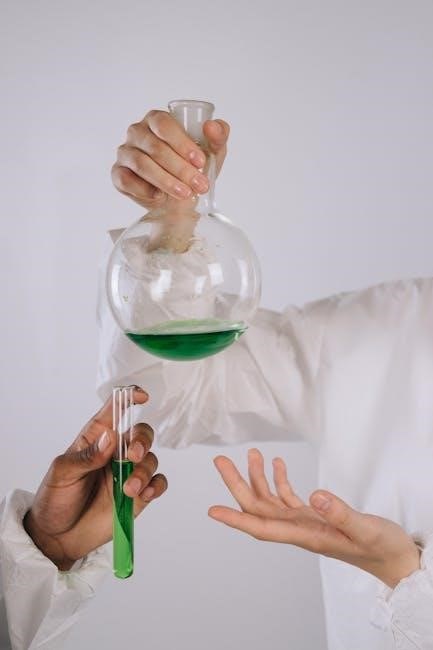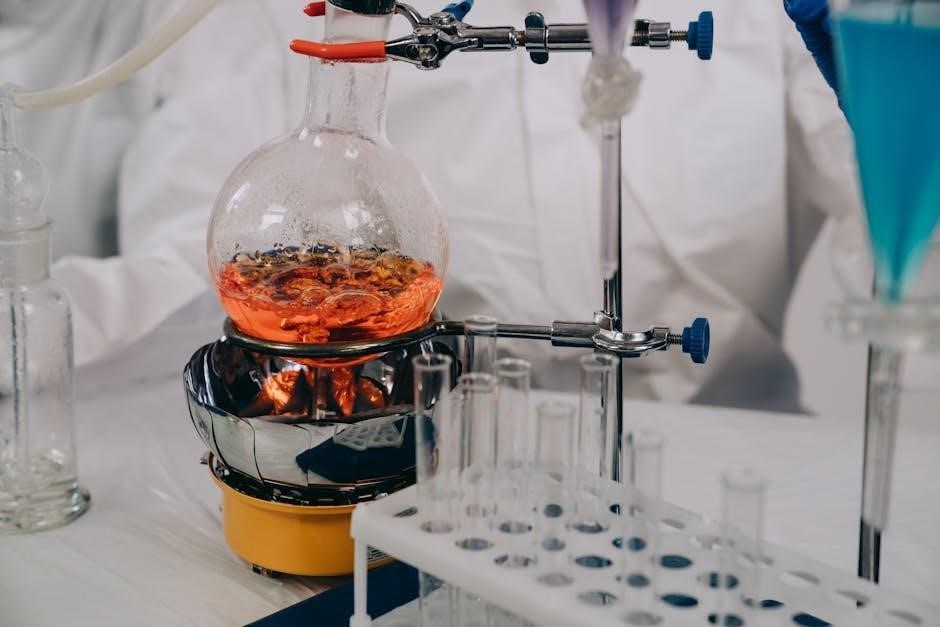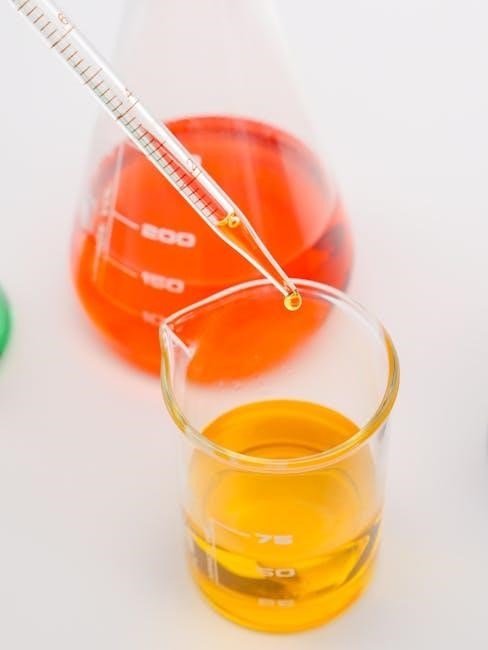The introduction to iodine clock reaction experiment is a classic demonstration of chemical kinetics, using iodine and other substances to show reaction rates and processes clearly explained online․
Overview of the Experiment
The iodine clock reaction experiment is a well-known chemistry demonstration that illustrates the principles of chemical kinetics․ This experiment involves the reaction of iodide ions with bromate ions in the presence of hydrogen ions, resulting in the formation of iodine․ The reaction is typically carried out in a controlled environment, with careful measurement of the reactants and products․ The experiment is often used to demonstrate the effects of concentration and temperature on reaction rates․ By analyzing the data collected from the experiment, students can gain a deeper understanding of the underlying chemical processes․ The experiment is widely available online, with many resources providing detailed instructions and explanations, including downloadable PDF files․ The iodine clock reaction experiment is a valuable tool for teaching chemical kinetics and reaction mechanisms․ It provides a clear and engaging way to illustrate complex chemical concepts․

Chemical Kinetics and the Iodine Clock Reaction
Chemical kinetics principles are demonstrated through the iodine clock reaction experiment using kinetics concepts and equations to analyze reaction rates and processes clearly․
Understanding the Reaction Mechanism
The reaction mechanism involves a series of complex steps, including the oxidation of iodide ions to form iodine, which then reacts with thiosulfate ions․ This process is facilitated by the presence of hydrogen ions and other reactants․ The reaction mechanism can be represented by a series of equations, which describe the various steps involved in the reaction․ By analyzing these equations, researchers can gain a deeper understanding of the reaction mechanism and the factors that influence it․ The reaction mechanism is a critical aspect of the iodine clock reaction experiment, and understanding it is essential for interpreting the results of the experiment․ The use of kinetics concepts and equations is crucial in analyzing the reaction mechanism and determining the reaction rates and processes․ This knowledge can be applied to various fields, including chemistry and physics․

Importance of Controls in the Experiment
Controls are crucial in the experiment to ensure accurate results and reliable data collection methods are used․
Validating the Laws of Chemical Kinetics
The iodine clock reaction experiment is used to validate the laws of chemical kinetics, which describe the rates of chemical reactions․ The experiment involves the reaction of iodide ions with bromate ions, producing iodine and other products․ By measuring the rate of this reaction under different conditions, such as varying concentrations and temperatures, students can gain a deeper understanding of the principles of chemical kinetics․ The data collected from the experiment can be used to determine the rate law and rate constant of the reaction, providing valuable insight into the underlying mechanisms․ This knowledge can then be applied to a wide range of real-world situations, from industrial processes to environmental systems, and is essential for developing new technologies and solving complex problems․ The experiment is a valuable tool for teaching and learning about chemical kinetics․

Graphical Representation of the Experiment
Graphs are used to represent the experiment data, showing the effects of variables on the reaction, using charts and plots to visualize the results clearly․
Effects of Vitamin C and Temperature on Reaction Time
The effects of vitamin C and temperature on reaction time are crucial aspects of the experiment, as they influence the rate of reaction․ Using a pdf file, researchers can analyze the data and observe the impact of these variables․ The reaction time is affected by the concentration of vitamin C, with higher concentrations resulting in faster reaction times․ Temperature also plays a significant role, as increased temperatures lead to increased reaction rates․ By analyzing the data, researchers can determine the optimal conditions for the reaction to occur․ The use of graphs and charts helps to visualize the results, making it easier to understand the effects of vitamin C and temperature on reaction time; This information is essential for understanding the chemical kinetics of the reaction․
Lab Report and Procedure
Lab report and procedure are documented in a pdf file for easy reference and analysis purposes online always․
Downloadable PDF File
The iodine clock reaction experiment pdf is a valuable resource for students and researchers, providing a comprehensive guide to the experiment․ The pdf file can be easily downloaded from various online sources, including academic websites and educational platforms․ The document typically includes a detailed introduction to the experiment, as well as step-by-step instructions for conducting the reaction․ Additionally, the pdf file may include graphs, tables, and other visual aids to help illustrate the concepts and results of the experiment․ By downloading the pdf file, users can access a wealth of information on the iodine clock reaction experiment, including its principles, procedures, and applications․ The pdf file is a convenient and accessible way to learn about this important chemical reaction, and can be a useful tool for both students and professionals in the field of chemistry․ The pdf is free to download online․
Reaction Mechanism and Equations
Chemical equations and mechanisms are explained using iodine reactions and processes clearly online with step details and diagrams showing reactions and equations involved clearly․
Step 1 and Step 2 Reactions
The iodine clock reaction involves two main steps, with the first step being the oxidation of iodide ions to form iodine, and the second step being the reduction of iodine to form iodide ions again․ The reaction mechanism is complex, involving multiple species and reactions․ The first step is the reaction between iodate ions and iodide ions to form iodine, which is then reacted with thiosulfate ions in the second step․ The reaction is highly dependent on the concentration of the reactants and the temperature of the solution․ The use of iodine and thiosulfate allows for a clear and visible indication of the reaction progress, making it a popular choice for educational demonstrations․ The step-by-step process of the reaction is well-documented online, with many resources available for further study․

and Future Directions
The experiment concludes with a clear understanding of chemical kinetics, using online resources for future study and development of new reaction methods clearly․
Applications of the Iodine Clock Reaction
The iodine clock reaction has various applications in chemistry and education, including demonstrating chemical kinetics and reaction rates, as seen in online resources and experiment pdf files․
These applications are useful for students and researchers, providing a clear understanding of chemical processes and reactions, using online materials and downloadable pdf files for reference and study․
The reaction is also used to study the effects of concentration and temperature on reaction rates, with results and data available online for analysis and comparison, as well as in pdf format for easy access and printing․
Overall, the iodine clock reaction is a valuable tool for learning and research, with many practical applications in chemistry and related fields, as discussed in online forums and experiment reports in pdf format․



